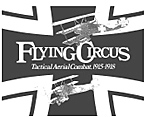
F is for... Flying Circus:
Tactical Aerial Combat, 1915-1918
SPI (1972, magazine edition $7.00)
Designed by James F. Dunnigan
Players 2 to 6
Playing Time 1 to 2 hours
Period World War I
Scale Tactical Turn 10 seconds
Map 60 meters
Unit individual aircraft
Components:
S&T 31 (March '72) SPI flat box with in mailing envelope cover sheet, or SPI white box with wrap-around Flying Circus sticker Inserts: S&T book service insert, feed-back response card, business reply envelope 28x22" unmounted mapsheet 200 die-cut counters rules folder sheet of 12 uncut German aircraft control cards sheet of 24 uncut Allied aircraft control cards 3/8" six-sided die
Counter Manifest:
6 different colored sets of 32 counters
22 aircraft numbered 1-22
3 target acquisition
3 speed
2 ammo
1 climb
1 trial
8 blanks
SPI says:
ďPlane to plane combat in the age of the knights of the air. Move ment and combat rules permit the recreation of the dog-fighting characteristic of the period. Famous aircraft included for use in the scenarios are: Fokker III, Dr I, D VIII, Albatross, Pfalz, Sopwith Camel, SPAD 13, Nieuport 11, SE 5A, and many others. Each aircraft type has its own customized control card used to keep track of its speed, ammunition, damage, and climbing. A streamlined version of the rules is also provided to introduce players to tactical aerial simulation.Ē
The reviewer says:
ďAlthough the title refers or seems to refer to larger numbers of aircraft, it is only possible to have three planes on each side . . . The rules contain a multitude of scenarios, including some that are open ended. A few are faulty as games. One Allied reconnaissance mission turned out to be an automatic victory for the Allied player. But most are true tests . . . Admittedly, it contains compromises, but it is still realistic, simple to operate, and challenging at the same time - a rare combination.Ē Martin Campion, Moves 4
Comments:
This simple World War I game followed close on the heels of the Guidon edition of Fight in the Skies. Both games served as inspiration for Randy Reed when he designed Richthofenís War.
The Flying Circus game system was used as the basis for Dunniganís World War II air combat game Spitfire (with a change in scale due to differences in aircraft performance). The game system even carried over into Foxbat & Phantom which shows some faint echoes of the Flying Circus game mechanics.
Unfortunately, Flying Circus lacked the personality and depth to stand up to its contemporaries. Both Fight in the Skies and Richthofenís War featured a larger selection of aircraft, more historical background information, and counters with individual aircraft silhouettes. The generic Flying Circus counters (numbered for altitude) were functional but bland. And the Richthofenís War mapboard marked a step forward for air combat boardgames. Its no surprise that Flying Circus dropped off the radar not long after its release while the competing titles managed to live on for years and years.
Collectorís Notes:
Those looking for a copy to play should be happy with any of the editions as the components are all the same. Cover art fans will want the flat box edition with its dramatic depiction of triplanes over an Iron Cross background. Avid readers will want the magazine edition in order to have some thing to read while their opponents are pondering maneuvers. Collectors, of course, will want all three.
Boone lists low/high/average prices of 10/40/18.46 at auction and 8/75/31.27 for sale.
Other World War I air combat boardgames:
Aces High, The American Aces, Red Baron (3W); Blue Max (GDW); Dawn Patrol (TSR); Fight in the Skies (Guidon & TSR); Knights of the Air, Richthofenís War (AH); Luftschiff (Sierra Madre); Wings (Yaquinto & Excalibre); Wings Over France (Lambourne); Zeppelin (SPI).
More Capsule Profiles F
- Introduction
Fall of South Vietnam A Game of Combat in South Vietnam: 1973-1975
Field of Honor A Game of Jousting Knights
Fight in the Skies A Realistic Game Simulating WWI Aerial Combat 4th ed
Flying Circus Tactical Aerial Combat, 1915-1918
Foxbat & Phantom Tactical Aerial Combat in the 1970ís
Fury in the West Battle of Shiloh - April 6 & 7, 1862
Back to Simulacrum Vol. 3 No. 1 Table of Contents
Back to Simulacrum List of Issues
Back to MagWeb Master Magazine List
© Copyright 2000 by Steambubble Graphics
This article appears in MagWeb (Magazine Web) on the Internet World Wide Web. Other military history articles and gaming articles are available at http://www.magweb.com